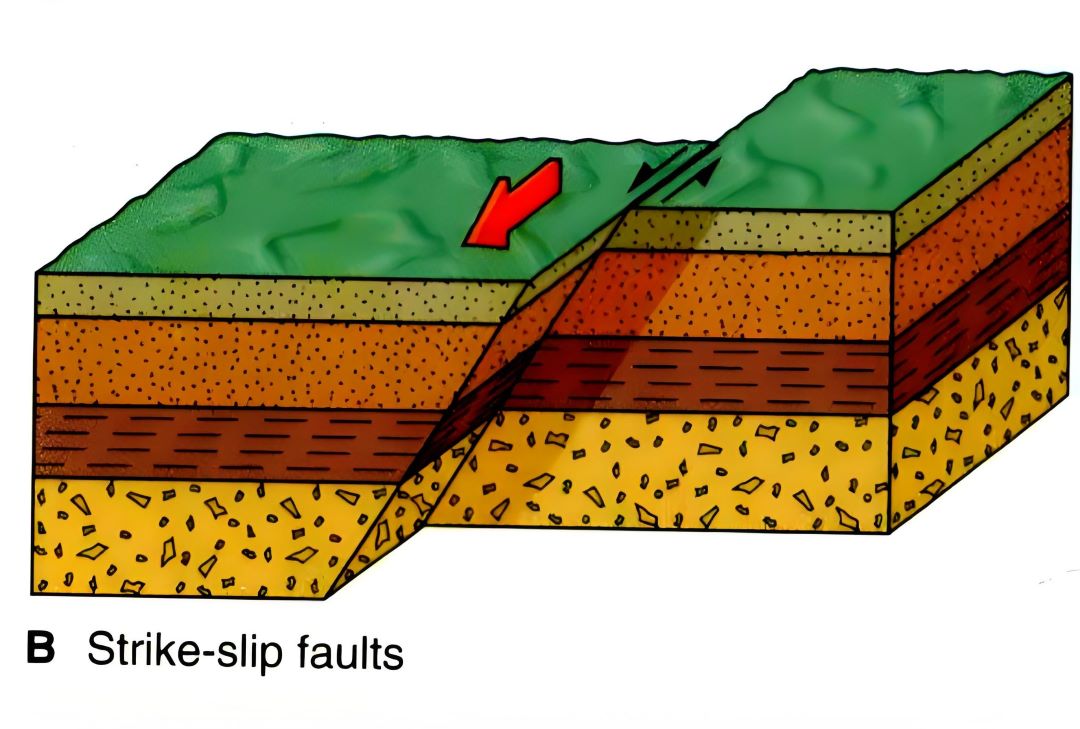What is a strike-slip fault? To understand a strike-slip fault, we first need to clarify its core definition: it is a geological structure in which rock blocks on either side of the fault slide primarily horizontally (rather than vertically) relative to each other. Essentially, it is the result of crustal rupture and displacement under the action of shear stress.

I. Core Characteristics of Strike-Slip Faults
1. Force Mechanism: Shear Stress Dominates
Unlike normal faults (where tensile stress causes the hanging wall to descend) or reverse faults (where compressive stress causes the hanging wall to ascend), strike-slip faults are driven by shear stress—two opposing forces parallel to the crustal surface. These forces, like twisting a towel, cause the rock to shift horizontally, ultimately fracturing and forming the fault.
2. Direction of Movement: Strictly Horizontal
The displacement of rock blocks on either side of the fault is primarily horizontal slip, with negligible vertical height differences. This horizontal slip is the key distinguishing characteristic of strike-slip faults from other faults.
II. Main Classifications of Strike-Slip Faults
Strike-slip faults can be divided into two categories based on the relative sliding direction of the rock blocks on either side of the fault. Identification is simple: stand on either side of the fault and observe the sliding direction of the rock blocks on the opposite side.
① Left-lateral strike-slip faults: Identification criteria: The rock blocks on the opposite side slide to the left.
② Right-lateral strike-slip faults: Identification criteria: The rock blocks on the opposite side slide to the right.
For example, if you stand on the west side of the San Andreas Fault, you will see the rock blocks on the east side (the Pacific Plate) slowly sliding to your right. This is a typical right-lateral strike-slip fault.
III. Formation Environment of Strike-Slip Faults
Strike-slip faults generally form in two geological settings: plate boundaries and continental interiors:
1. Transform faults at plate boundaries
Transform faults form when two plates slip horizontally along their boundaries (rather than collide or separate). These are essentially the largest strike-slip faults. For example:
Transform faults on the Mid-Atlantic Ridge: The Mid-Atlantic Ridge is a plate-diverging zone (a spreading center), but the spreading rates vary between different sections, requiring transform faults to "regulate" horizontal slip and prevent fractures.
2. Shear zones within continents
Strike-slip faults can also form within continental plates if they are subjected to "indirect shear forces" from remote plate movement. For example:
China's Tanlu Fault Zone: Influenced by remote stresses from the Pacific Plate subducting the Eurasian Plate, this fault forms a large right-lateral strike-slip fault that runs through eastern China.
Strike-slip faults are characterized by "horizontal slip" driven by shear stress. They can be divided into left-lateral and right-lateral types. They are widely distributed along plate boundaries and within continents, shaping unique surface landforms and serving as a key geological structure for triggering strong earthquakes. Understanding them is crucial for earthquake early warning, geological disaster prevention, and resource exploration (such as oil and gas reservoirs).





